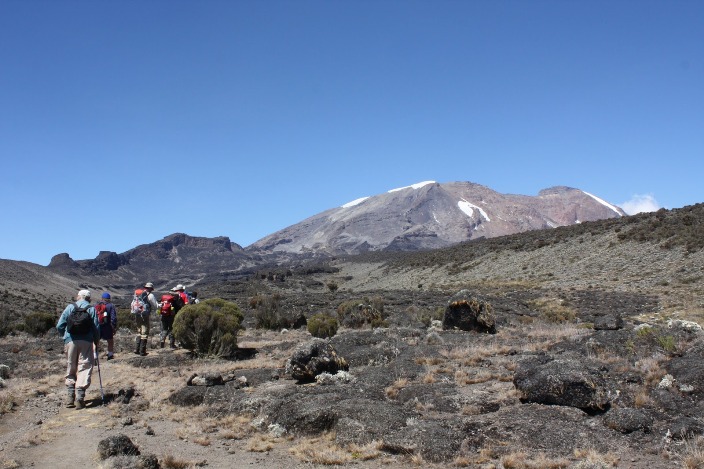RONGAI (OLOITOKITOK) ROUTE

Tour Overview
The only route that tackles Kilimanjaro from the north side. This offers an exclusive journey to the summit. The neighbouring Kenyan region provides the scenic plains of the Maasai land where conspicuous splotches of wildlife including buffalo, elephants and monkeys emerge. This is the least frequented trail and the tranquillity compels East Africa’s fascinating birdlife and you may encounter some of the diverse wildlife whilst on your trek. The drive to get to the gate it is filled with fantastic sights. In the rainy seasons the route is ideal because the north side receives less precipitation, permitting a safer trek.
Mt Kilimanjaro climbing, trekking. Rongai Route (8 day)
At 19,336 feet, snow-capped Mount Kilimanjaro in Tanzania is Africa’s highest peak. It is the world’s tallest walkable mountain, and what a walk it is. You go through 5 different climatic zones to reach the summit.
The Itinerary
Day 1: Arrival – Arusha
On arrival at Kilimanjaro Airport, met and assisted. Transfer to a hotel for an overnight. Dinner and Overnight.
Day 2: Rongai Gate (1950m) – 1st Caves camp (2600m)
Hiking time: 5 hours
Distance: About 8 km’s
Habitat: Montane forest
Register at the Marangu park gate with a transfer (approximately 2 ½ hours) to the Rongai trailhead. Meet your guide and porters before you begin your hike from the Nale Moru village. The small winding path crosses maize fields before entering pine forest, and then climbs gently through a forest. The trail is not at all steep, but is rather a gentle hike through beautiful country. The first night’s camp is at First Cave, at about 2,600 metres. There is a toilet and a wooden table with benches, but no hut. Water can be found just down the trail below First Cave.
Day 3: 1st Cave (2600m) – Kikelewa Cave (3600m)
Hiking time: 6-7 hours
Habitat: Moorlands
The trail continues up towards Kibo, passing Second Cave (3450m) en-route, and reaching Kikelwa Cave at about 3600 metres. The views start to open up and you begin to feel you’re on a really big mountain! Water is in the obvious stream below the cave, although you might have to wander downhill a way to find some. Overnight at 3rd Cave camp (Kikelewa Caves).
Day 4: Kikelewa Cave (3600) – Mawenzi Tarn camp (4330m)
Hiking time: 3-4 hours
Habitat: Moorlands
A short but steep climb up grassy slopes offers superb views of this wilderness area. The vegetation zone ends shortly before you reach your next camp at Mawenzi Tarn spectacularly situated beneath the towering spires of Mawenzi. Spend the afternoon acclimatizing and exploring the area.
Day 5: Mawenzi Tarn camp (4330m) – Kibo hut (4700m)
Hiking time: 4 – 5 hours
Habitat: Alpine desert
Rongai Day 4Continue ascending on the east side of Kibo crossing the saddle between Mawenzi and Kibo taking 4 to 5 hours to reach Kibo Hut. The remainder of the day is spent resting in preparation for the final ascent, which begins around midnight. Overnight at Kibo Camp
Day 6: SUMMIT ATTEMPT
Kibo hut (4700m) – Uhuru Peak (5895m) – Horombo hut (3720m)
Hiking time: 8 hours to reach Uhuru –
6 hours to descend to Horombo
Distance: 6 km’s ascent – 21 km’s descent
Habitat: Stone scree and ice-capped summit
You will rise around 23h30, and after some tea and biscuits you shuffle off into the night. This is where the going really gets tough. The first section of the trail consists of a rocky path to the Hans Meyer Cave (5150m), also a good resting spot. The path then zigzags up to Gillman’s point (5 681m), which is located on the crater rim. This section is very steep with a lot of stone scree, requiring a great physical and mental effort. Probably the most demanding section of the entire route. Do the Kili shuffle and move slowly. From Gillman’s Point you will normally encounter snow all the way up to Uhuru peak (5895m), the highest point in Africa. Total exhilaration and satisfaction – you made it. Weather conditions on the summit will determine how long you can spend, taking photographs, before the 3-hour descent back to Kibo hut. After a short rest you gather all your gear for the ascent and head down to Horombo hut (3 hours) where you will overnight. The return to Horombo hut will seem surprisingly fast compared to the ascent. The total time spent walking on this day is around 14 hours, so be prepared for a very tough day. Later in the evening you enjoy your last dinner (with soft drinks and beer for sale at the camp office) on the mountain and well-earned sleep, filled with memories and stirring emotions.
Day 7: Horombo hut (3720m) – Marangu Gate (1980m)
Hiking time: 6 hours
Distance: About 27 km’s
Rongai Day 4After breakfast you continue your descent (6 hours), passing the Mandara hut, down to the Marangu gate. It is strongly recommended not to pay your porters any tips until you and all your gear have reached the gate safely. Click here for more info on tips. At Marangu gate you sign your name and details in a register. This is also where successful climbers receive their summit certificates. Those climbers who reached Gillman’s Point (5685m) are issued with green certificates and those who reached Uhuru Peak (5895m) receive gold certificates. You now drive back to Moshi for a long overdue hot shower, dinner and celebrations!! Overnight in Springlands hotel.
Day 8: Departure
Transfer to Kilimanjaro Airport for your flight back home or continue with your safari schedule.


